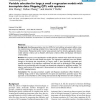Free Online Productivity Tools
i2Speak
i2Symbol
i2OCR
iTex2Img
iWeb2Print
iWeb2Shot
i2Type
iPdf2Split
iPdf2Merge
i2Bopomofo
i2Arabic
i2Style
i2Image
i2PDF
iLatex2Rtf
Sci2ools
BMCBI
2008
2008
Variable selection for large p small n regression models with incomplete data: Mapping QTL with epistases
Background: Identifying quantitative trait loci (QTL) for both additive and epistatic effects raises the statistical issue of selecting variables from a large number of candidates using a small number of observations. Missing trait and/or marker values prevent one from directly applying the classical model selection criteria such as Akaike's information criterion (AIC) and Bayesian information criterion (BIC). Results: We propose a two-step Bayesian variable selection method which deals with the sparse parameter space and the small sample size issues. The regression coefficient priors are flexible enough to incorporate the characteristic of "large p small n" data. Specifically, sparseness and possible asymmetry of the significant coefficients are dealt with by developing a Gibbs sampling algorithm to stochastically search through low-dimensional subspaces for significant variables. The superior performance of the approach is demonstrated via simulation study. We also ap...
| Added | 09 Dec 2010 |
| Updated | 09 Dec 2010 |
| Type | Journal |
| Year | 2008 |
| Where | BMCBI |
| Authors | Min Zhang, Dabao Zhang, Martin T. Wells |
Comments (0)

